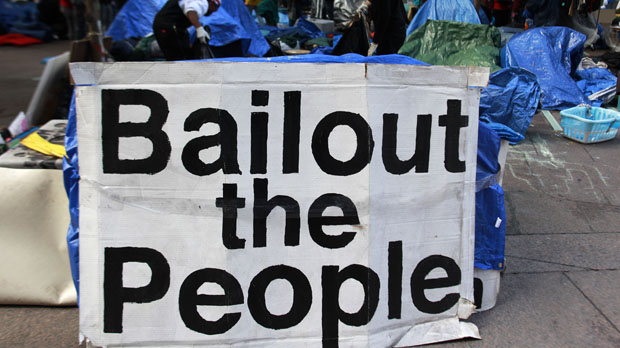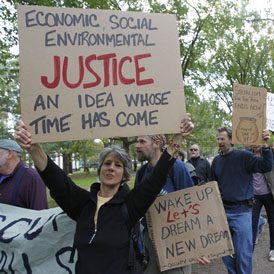Where now for the Occupy protesters?
It has led to the resignation of two of St Paul’s cathedral’s senior clergyman and caused the shutdown of one of the US’s largest ports. Channel 4 News asks what is next for the Occupy movement.

Inspired by the popular display of dissatisfaction and anger of the Arab Spring, the non-hierarchical network of camps and protests around the world which unites under the Occupy name (#Occupy on Twitter) had a grand plan.
It would use peaceful means to figure out an alternative to a global system in which inequality is king. The links to its Arab progenitor included the use of social media such as Twitter to organise as well as more recently the personification of financial institutions as the “Global Mubarak”.
People are worried and angered by how big inequalities have grown Richard Wilkinson
According to the Occupy Together website, there are now over 450 occupations registered globally from Newcastle to New Haven but some estimates put the total at over 900 in more than 80 countries.
The protests range from the tiny to the massive but all are united on at least one thing: the refusal to tolerate the “greed and corruption of the one per cent”.
No blueprint needed
Arguably it can trace its inception to the occupation of several Spanish cities by “los indignados” (the indignant) in May. But since then it has become a more coherent entity.
The movement is very social media-savvy, meaning it is able to spread updates, audio, live video feeds, although its nature – a wide-ranging network rather than a centrally-organised hierarchical organisation – can mean it is less easy to contact for example, press spokespeople.
As it has attracted more public attention, many people have asked what it wants to achieve and how. In a relatively short space of time (the first major protest, Occupy Wall Street, began on September 17,) the movement has grown in scale and in visibility.
Tim Gee, author of Counterpower which investigates why social movements succeed or fail, has visited several of the UK occupations and believes the point of Occupy is to develop ideas:
“The movement hasn’t and shouldn’t have a blueprint.
“Firstly because very few movements’ blueprints get adopted in their entirety and secondly there are so many alternatives and the point is to defend and promote as many of those as possible by taking power away from the financial elites.”

It appears each country’s occupations stem from different but related campaigning issues. Tim Gee told Channel 4 News he thinks Occupy in the UK has come from several sources: “I see, at least in Britain, it coming from three different strands: the Arab Spring, the long-standing anti-corporate movement and the student youth movement which occupied university campuses last year.
He says co-incidentally there are also shades of similarity to a much earlier revolution in the middle-east when in 1906 people in Persia camped outside the British embassy demanding limits on the Shah’s power: “People set up their own open air school, a bit like the Tent City University outside St Paul’s in London, and they gave speeches about democracy. An electoral system was established before the year was out.”
Pan-political support
Richard Wilkinson who co-wrote best-selling socio-economic treatise “The Spirit Level” about societal inequality told Channel 4 News why it has emerged now: “I think that opposition to the huge income differences and bonus culture has been growing slowly since the financial crash and that the Occupy movement is a clear manifestation of that.
“People are worried and angered by how big inequalities have grown.
“As a Guardian editorial commented, there is now not much difference in reporting of the St Paul’s Occupation from the Financial Times to the Guardian: instead of dismissal of the protests there are widespread signs of sympathy.
“I also think that this is part of a wider political change. Throughout much of the developed world the political pendulum has been swinging to the right since the end of the 1970s, it has now started to swing back.”
Local conservative MP Mark Field, writing about the Occupy camp at St Paul’s cathedral, noted: “the protestors’ message taps into a deep sense of unease, impotence and frustration amongst people who, despite having got themselves educated and then worked and saved hard, now view themselves as the losers of the globalised, capitalist system.”
Occupy forever?
As for what is next, Richard Wilkinson told Channel 4 News the campaign needs to continue to educate people: “Surveys show that a large majority of the population think income differences are too large even though the same surveys also show that people are not nearly aware of how unequal our society actually are. Campaigns needs to have a large educational component”
Tim Gee said the movement is like a global workshop for new ways of doing things and as such will develop: “If it is to be successful it needs to turn into something else and I don’t know what that is yet.
“Currently, it’s making a democratic space to talk about ideas of how to redistribute power from the 1 per cent to the 99 per cent. Any movement which redistributes power from the few to the many is successful.
“The Occupy movement has managed to get a rebuke for the financial system onto the front pages. However, do global financial institutions still have power? Yes they do. That’s why this movement has to keep going. It might change how it manifests itself but we have to keep up the pressure.”
Perhaps a measure of its success is a call on Thursday from disillusioned Egyptians for support from Occupy protestors for the continuation of the Egyptian uprising which they fear has stalled, despite the overthrow of President Mubarak in February.